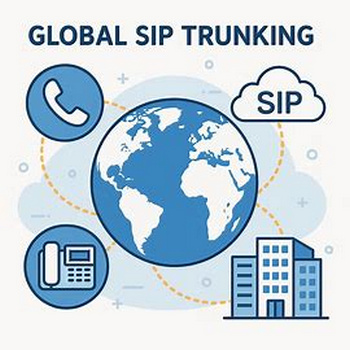Introduction: Why “Global SIP Trunking” Matters
If your business spans borders, making international calls and getting people to pick up is half the battle. That’s where Global SIP Trunking from aitelephone comes in.
Think of it as your digital “highway” for voice: you can call anywhere in the world over the internet, and—with the right setup—your calls can appear as local ones to your recipient. This provides significant advantages in cost, reliability, and user experience.
Get enterprise-grade cloud phone numbers and full cloud communications solutions in more than 160 countries worldwide. With our global SIP trunking infrastructure, you can instantly provision local and toll-free numbers across the globe, route calls with confidence, and maintain crystal-clear call quality on a resilient, carrier-grade network.
Our globally distributed voice fabric ensures low latency, redundancy, and consistent reliability—so your business can connect that local touch to customers, no matter where they are.

What Is Global SIP Trunking?
At its core, SIP (Session Initiation Protocol) trunking lets businesses connect their phone systems (e.g. PBX, cloud phone platforms, or VoIP infrastructure) to the public telephone network via the internet instead of old copper or ISDN lines.
Global SIP Trunking extends this concept by offering voice termination (and sometimes origination) in many countries globally. Your phone system sends outbound calls to the SIP provider via the internet, which then routes them to the recipient’s local network.
Key Benefits of Global SIP Trunking
- 💸 Cost savings — no need for separate international circuits
- 📈 Scalability — add more “channels” or capacity as needed
- 🌍 Global reach — call many countries using a single provider
- 🛠️ Feature flexibility — configure caller ID, routing rules, failover, etc.
International Outbound Calls + Caller ID Strategy
One major challenge in international calling is trust. If someone in Germany sees a caller ID from the U.S. or an unknown prefix, they’re less likely to answer, hurting contact rates. Showing a local caller ID changes the game and improves answer rates.
Showing Your Business Number as Caller ID (Including Local IDs)
Many global SIP trunk providers let you configure your outbound Caller ID to display any number you own (with compliance). You can also assign local numbers in the regions you’re calling:
- If calling the UK, show a UK local number as Caller ID
- If calling Brazil, show a Brazil local number
This builds trust and can double or more your response rates when calls appear local.
To implement this:
- 🛡️ SIP trunk provider must support configurable outbound caller ID or “caller ID override”
- 🏷️ You must own or provision local numbers or DIDs in the target region
- 🏢 Provider should have local voice termination or “anchor sites” so calls emerge locally
- 🌐 Many providers offer “local caller ID” in dozens to 150+ countries
This increases connection rates and makes recipients more comfortable answering familiar numbers.
Integration: PBX, Softphone, or Cloud
You have options for integration:
- 🏢 Connect your on-premises PBX or phone system to the SIP trunk
- 📱 Use a softphone (desktop or mobile app) for outbound calls
- ☁️ Use a hybrid or cloud-PBX setup with SIP routing
Option A: Connect SIP Trunks to Your Existing Phone System
If you have a PBX (on-prem or virtual), configure SIP trunks pointing to the provider’s SIP endpoints. You may need a session border controller (SBC) or security gateway. Once set up, outbound routes are sent via the SIP trunk; inbound calls to your DIDs are routed to your system.
Option B: Use the Free Softphone
If you lack a physical PBX, use a softphone like a smartphone or desktop VoIP client. Configure it with provider credentials and make outbound calls over the SIP trunk—no extra hardware needed. Entry into global calling is simple and low-cost.
In both setups, you can present a local caller ID for international calls, with differences mainly in user experience and infrastructure.
Best Practices to Maximize Success
Here’s how to get the most from Global SIP Trunking:
- 📞 Use local caller ID to boost answer rates
- 📊 Monitor quality metrics (jitter, packet loss, latency) and pick routes that meet SLAs
- 🔄 Enable redundancy/failover so calls always succeed
- 🧮 Route smartly using cheaper/high-quality paths or fallback routes
- 📈 Use analytics and feedback loops to refine caller ID or routing by territory
Learn more about Global Sip Trunking and Virtual Phone Numbers here



